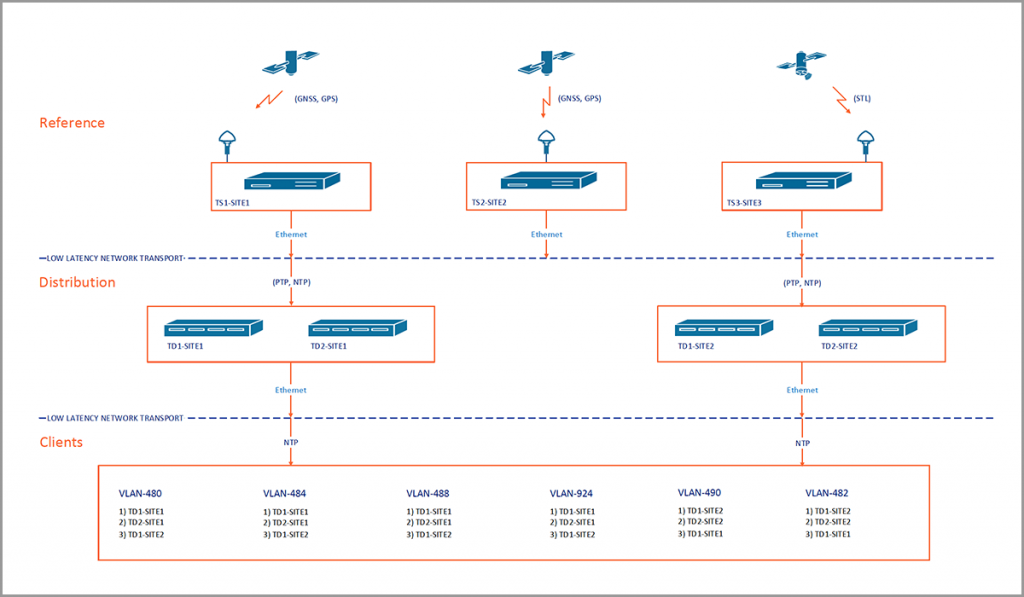# Case Studies
A Hierarchical Timing Topology Gets a Sporting Chance to Improve This Distributed Network
Background
A live sports broadcasting enterprise with multiple sites and a distributed network was getting its time references via internet time servers, including regional NIST and NTPNTP, or Network Time Protocol, is a widely used networking protocol that enables computers and devices to synchronize their system clocks with a reference time source. It ensures accurate timekeeping in computer networks by allowing devices to obtain precise time information from NTP servers, which are typically synchronized to highly accurate atomic clocks. NTP is essential for various applications and services that rely on synchronized time, such as network security, authentication, and data logging. pool servers … and it wasn’t working out. Their applications were very sensitive to time sync delays, and their time traffic was passing though insecure firewalls. They needed to do better.
Solution
Orolia suggested an enterprise hierarchical timing topology instead, utilizing multiple layers: a time reference layer, a time distribution layer, and a client hand-off layer.
The benefits of a hierarchical timing topology are significant:
- It provides high availability and a resilient network time layout
- It supports distributed architecture for better time accuracy and minimum delays
- Failover is embedded in the design at multiple layers
- It is scalable and flexible for future capacity growth and technology upgrades, with minimal change(s) in the design
- It eliminates the need for internet time servers and firewalling time traffic
- Time accuracy significantly improves because the time signal no longer needs to pass through firewalls
- It can be tailored to specific requirements and replaces aging infrastructure
The customer indicated that they wanted assistance on designing, deploying and maintaining their timing infrastructure, so we also included a consulting proposal for our engineering services, to include timing network design and deployment and advanced system architecture.

For the reference layer, Orolia recommended three time servers set up at geographically redundant sites whose key functions would be to:
- Provide time to the Time Distribution (TD) servers over low latency transport, using PTPPrecision Time Protocol is a protocol used to synchronize clocks throughout a computer network. On a LAN network, PTP can enable the clocks on each server to be synchronized within a sub-microsecond range, thus making it suitable for demanding applications that require precise timing and control. PTP is standardized within IEEE-1588v2. or NTP
- Receive time from GNSSGlobal navigation satellite system (GNSS): A general term describing any satellite constellation that provides positioning, navigation, and timing (PNT) services on a global or regional basis. See also and STL Satellite Time & Location Service. STL provides a backup signal for GNSS in the event of a signal outage, it is 1000x stronger than GNSS, and it installs directly into the server rack
We recommended that they include the following Orolia products in this reference layer:
- A SecureSync® resilient time server for redundancy
- IDM Suite (Interference, Detection and Mitigation) components, including an Orolia 8230AJ Anti-Jam Antenna, GPSdome anti-jammer, multi-GNSS receivers, and an STL card
- Ethernet Option Card, Dual Power, PTP Card, Rubidium
For the distribution layer, we recommended four time distribution servers, two across each site, set up in at least two different geographically redundant sites, in proximity to the reference and client handoff sites. The functions of this layer would be to:
- Provide time to the client handoff over low latency switching using primarily NTP
- Receive time from three Time Source (TS) servers over low latency transport , using PTP or NTP
For this layer, we recommended a SecureSync (OCXO internal oscillator) with an ethernet option card dual power supply.
For the client handoff layer, which would consist of client devices in various networks and subnets and receive time from the time distribution layer, we recommended a minimum of three time distribution servers per client, with at least two of these local and one remote. This design would support both NTP and PTP when required.
The customer indicated that they wanted assistance on designing, deploying and maintaining their timing infrastructure, so we also included a consulting proposal for our engineering services, to include timing network design and deployment and advanced system architecture.
Background
Using this hierarchical timing topology, the customer can achieve millisecond accuracy and redundancy in their timing network with increased cybersecurity. They no longer must go outside their firewalls to get less-than accurate time. Their transactions are no longer delayed, and their customers are no longer complaining.


